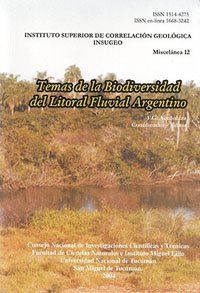Miscelánea 12
Cocodrilos en la Región Litoral: especies, distribución geográfica, modo de vida.
Carlos Ignacio Piña | Alejandro Larriera | Pablo Siroski
Descargar trabajo en formato PDFAbstract
CROCODILES IN LITORAL REGION: SPECIES, GEOGRAPHIC DISTRIBUTION, AND LIFE HISTORY. Crocodiles have been in the earth for 220 MY. On their evolution they have occupied a wide variety of habitats, from terrestrial to sea habitats. They are ecologically beneficious for their habitats. Benefits are selective depredation, nutrient recycling, and maintenance of wet refuges during severe droughts. Presently, the most endangered species are in such situation because of habitat loss, not poaching. Of the 23 species of the order Crocodylia, ten can be found in Latin America, included in Caiman, Crocodylus, Melanosuchus, and Paleosuchus genera, but only two can be found Argentina, Caiman latirostris (Broad Snouted Caiman) and Caiman yacare (Yacare Caiman). Both species share most of their distribution, but C. latirostris goes further south than C. yacare because it’s wider temperature tolerance. In recent years there were records of nesting as south as El Rico Island (32° 16’S; 60° 40’ O; Natural Reserve of Santa Fe province) in the Paraná River, but there are no censuses of those marginal populations in Santa Fe and Entre Ríos provinces. Conservation programs, based on sustainable use, act as tool of protection for natural ecosystems, and produce a considerable amount of scientific information for the species and their habitats. In January 2002 we trapped nesting females that have been released in the wild by Proyecto Yacaré in 1991 and 1992 as part of the self-recovering population program for the species.






